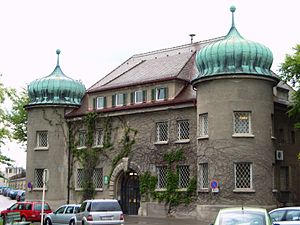Landsberg prison

Entrance to Landsberg Prison
|
|
| Location | Landsberg am Lech, Bavaria, Germany |
|---|---|
| Coordinates | 48°03′15″N 10°52′00″E / 48.05417°N 10.86667°ECoordinates: 48°03′15″N 10°52′00″E / 48.05417°N 10.86667°E |
| Status | Operational |
| Capacity | 800 |
| Population | ~724 average |
| Opened | 1910 |
| Former name | War Criminal Prison Nr. 1 |
| Managed by | Bavarian Ministry of Justice |
Landsberg Prison is a penal facility located in the town of Landsberg am Lech in the southwest of the German state of Bavaria, about 65 kilometres (40 mi) west of Munich and 35 kilometres (22 mi) south of Augsburg. It is best known as the prison where Adolf Hitler was held in 1924, after the failed Beer Hall Putsch in Munich, and where he dictated his memoirs Mein Kampf to Rudolf Hess.
The prison was used by Allied power during the Occupation of Germany for holding Nazi War Criminals. In 1946 General Joseph T. McNarney, commander in chief, U.S. Forces of Occupation in Germany renamed Landsberg: War Criminal Prison Nr. 1. The Americans closed the war crimes facility in 1958. Control of the prison was then handed over to the Federal Republic of Germany.
Landsberg is now maintained by the Prison Service of the Bavarian Ministry of Justice.
Landsberg prison, which is in the town's western outskirts, was completed in 1910. The facility was designed with an Art Nouveau frontage by Hugo Höfl. Within its wall, the four brick-built cell blocks were constructed in a cross-shape orientation. This allowed guards to watch all wings simultaneously from a central location (based on the Panopticon style).
Landsberg, which was used for holding convicted criminals and those awaiting sentencing, was also designated a Festungshaft (meaning fortress confinement) prison. Festungshaft facilities were similar to a modern protective custody unit. Prisoners were excluded from forced labor and had reasonably comfortable cells. They were also allowed to receive visitors. Anton Graf von Arco-Valley who shot Bavarian prime minister Kurt Eisner was given a Festungshaft sentence in February 1919.
...
Wikipedia
